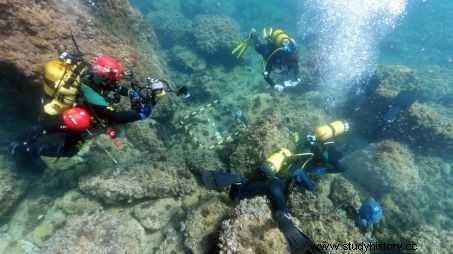Two amateur divers found by chance at the bottom of the Mediterranean, in the bay of Portitxol, in Spain, an exceptional treasure made of gold coins dating from the end of the Roman Empire. It is one of the largest sets of this type ever discovered.

Three of the 53 gold coins found in a small cavity off the coast of Xàbia, in the bay of Portitxol.
Who has never dreamed of diving into a turquoise sea and seeing the reflection of a treasure at the bottom of the water? This is precisely what happened on August 23, 2021 to two amateur divers who were swimming in the bay of Portitxol, on the Spanish coast. The brothers-in-law Luis Lens Pardo and César Gimeno Alcalá, then on vacation, rent snorkeling equipment that day with the aim of cleaning the bottom of the sea of some of its waste. But during his journey, Luis Lens Pardo's eye was caught by a small golden glow, he told the daily El País .
He finds that it is that of a coin that "is in a small hole, like a bottleneck" , he explained to the newspaper. After cleaning it, the two men notice that it is struck "with an ancient image, like a Greek or Roman face" . They therefore decide to return to the location of their find, at the bottom of the water, this time equipping themselves with a small corkscrew. In total, they manage to remove eight coins from the cavity.
Anxious not to damage the pieces by imposing too sudden a change of environment on them, Luis Lens Pardo and César Gimeno Alcalá kept them in a jar filled with seawater and notified the authorities the next day. A team of archaeologists from the University of Alicante and the Archaeological and Ethnological Museum Soler Blasco then meets to examine the objects. The observation is quick:these are Roman coins. With the help of the Special Underwater Brigade of the Spanish Civil Guard and the Xàbia City Council, it is decided that a new dive should be organized to better explore the cache discovered by vacationers.
No less than 53 gold coins in perfect condition
This time, expert divers bring to the surface no less than 53 gold coins dating from 364 to 408 AD, a time that corresponds to the decline of the Western Roman Empire. All are so well preserved that it is easy to identify the different Roman emperors represented. Among them are Valentinian I, Valentinian II, Theodosius I, Arcadius and Honorius, a statement from the University of Alicante tells us. The treasure also includes three nails, probably copper, and the weathered lead remains of what may have been a chest that held the riches.

The find site. Credits:University of Alicante
The find constitutes one of the largest known collections of Roman gold coins in Europe, said Jaime Molina Vidal, professor of ancient history at the University of Alicante and leader of the team that helped to assess and recover the treasure buried under the Mediterranean.
Hidden in a hurry
In addition to its material value, the hoard is also exceptional for what it tells us about the troubled period of history in which it falls, that of the fall of the Western Roman Empire. In 395 AD, the Roman Empire was divided into two parts:the Western Roman Empire, of which Rome was the capital, and the Eastern Roman Empire (or Byzantine), centralized in Constantinople. In the aftermath, the Barbarians – name given by the Romans to the various tribes of Europe that did not belong to the Empire – took advantage of this to invade the politically weakened western areas. This is the case of Hispania, the name of the Iberian Peninsula, which was occupied by the Suevi, the Vandals and the Iranian Alans from 409.
Because archaeologists have found no evidence of a sunken ship near the cavity in which the coins lay, it is possible that someone deliberately buried the treasure there, " perhaps to hide it from the Barbarians, probably the Alans" , says Jaime Molina Vidal. It could have belonged to a wealthy landowner, power having shifted at that time from the cities to the countryside, where large Roman villas were located. "The discovery tells us about a context of fear, a world that is ending - that of the Roman Empire" , concludes the archaeologist.
